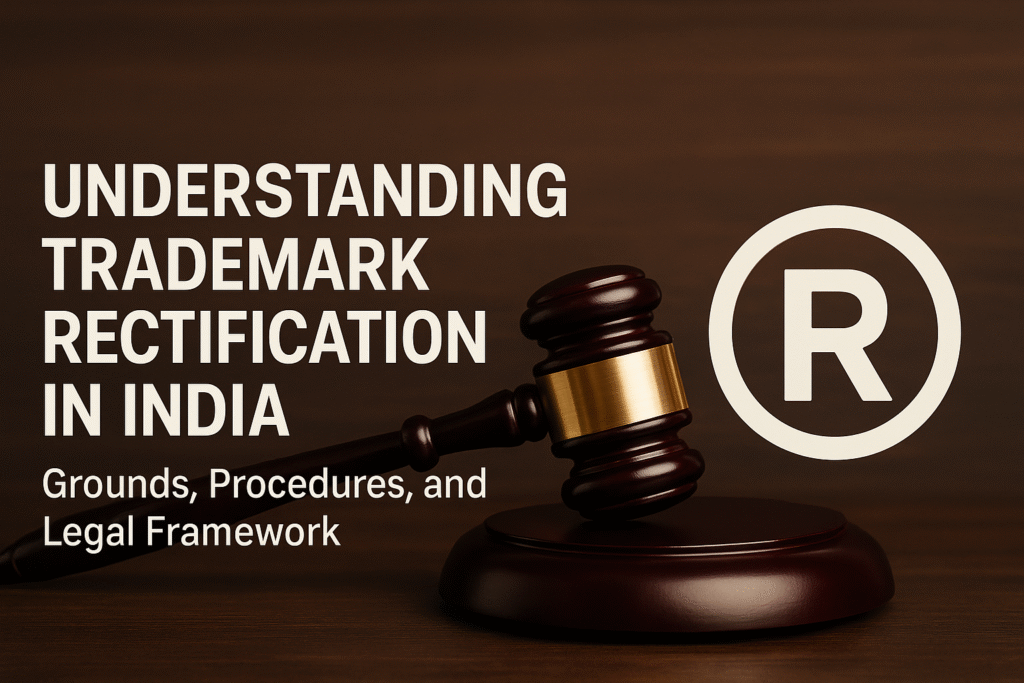
Trademark rectification is a legal process in India that allows for the correction, removal, or variation of entries in the Trademark Register. This mechanism ensures that the register accurately reflects the current status and validity of trademarks, thereby maintaining the integrity of intellectual property rights.
When and How Do Rectification Proceedings Take Place?
1. Initiation of Proceedings
Rectification proceedings can be initiated by:
- Any Person Aggrieved
- The Registered Proprietor
- Registrar’s Own Motion
2. Grounds for Rectification
a. Section 47 provides specific grounds related to non-use of a trademark:
- Lack of Bona Fide Intention and Non-Use: If the trademark was registered without any bona fide intention of use by the proprietor and has not been used up to three months before the rectification application is filed.
- Continuous Non-Use for Five Years: If the trademark has not been used for a continuous period of five years from the date of its registration and up to three months before the application for removal is filed.
b. Section 57 of the Trade Marks Act, 1999, outlines the grounds for rectification:
- Contravention or Failure to Observe a Condition: If the trademark registration violates any conditions entered in the register.
- Absence or Omission of an Entry: If essential entries, such as disclaimers or limitations, are missing.
- Entry Made Without Sufficient Cause: If the registration was obtained by fraud, misrepresentation, or without bona fide intention to use the mark.
- Error or Defect in an Entry: If there is a clerical or procedural mistake in the registration details.
- Mark Wrongly Remaining on the Register: If the mark is contrary to the provisions of the Act or is likely to cause confusion among the public and trade.
- Non-Use of the Trademark: If the trademark has not been used for a continuous period of five years from the date of registration.
- Non-Payment of Renewal Fee: If the renewal fee has not been paid, leading to the mark’s removal from the register.
c. Section 68 deals with rectification related to collective and certification trademarks:
- Non-Compliance with Conditions or Rules: If the registered proprietor of a collective or certification trademark fails to observe the conditions or rules governing its use.
- Misuse Contrary to Public Interest: If the mark is used in a way that is misleading or contrary to the intended purpose of a collective or certification mark, or is inconsistent with public interest or the provisions of the Act.
d. Section 77 allows for rectification or cancellation on broader grounds involving public policy and legality:
- Contrary to Law or Public Order: If the registration or continued presence of the trademark on the register is found to be contrary to legal provisions, morality, or public order. This includes scenarios involving marks that should not have been registered due to their impact on the public, including well-known trademarks or marks likely to cause public confusion or harm.
e. Additional Practical Grounds:
- Non-Use of the Trademark: If the trademark has not been used in trade for a continuous period of five years after registration, as provided under Section 47.
- Non-Payment of Renewal Fee: If the renewal fee is not paid within the prescribed time frame after the expiry of the registration period, the mark may be removed from the register under Section 25, read with Section 57.
3. Procedure for Rectification Under Rules 97 to 100 of the Trade Marks Rules, 2017
The rectification process is governed by specific procedural rules under the Trade Marks Rules, 2017, which ensure that both parties have a fair opportunity to present their case. Here’s a breakdown of the relevant provisions:
a. Rule 97: Filing the Rectification Application
An application for rectification or cancellation of a trademark under Sections 47, 57, 68, or 77 of the Trade Marks Act, 1999, must be filed using Form TM-O. The application should include:
- A detailed statement of the applicant’s interest in the trademark.
- The facts forming the basis of the request.
- The relief sought, such as removal, correction, or variation of entries.
If the applicant is not the registered proprietor, the application must be submitted to the Trade Marks Registry and must be accompanied by additional copies if there are registered users. The Registrar will transmit a copy of the application and statement of case to:
- The registered proprietor
- Any registered users
- Any other person listed in the register as having an interest in the mark
The application must also be verified in the same manner as a notice of opposition under Rule 43(c)(i).
b. Rule 98: Responding to a Rectification Application
The registered proprietor has three months from receiving the application to file a counterstatement using Form TM-O. If a counterstatement is filed:
- The Registrar will serve a copy to the applicant within one month.
If no counterstatement is filed within the three-month window:
- The applicant may proceed by submitting evidence supporting the rectification claim, as per Rule 45(1).
- The subsequent procedure aligns with Rules 46 to 51, which cover the exchange of evidence and the conduct of hearings.
c. Rule 99: Intervention by Third Parties
Any third party who is not the registered proprietor but claims to have an interest in the trademark may apply to intervene using Form TM-O. The application must clearly state the nature of the interest. The Registrar has the discretion to:
- Allow or reject the intervention request.
- Impose terms or conditions, such as security for costs
Conclusion
Trademark rectification is a crucial process for maintaining the accuracy and integrity of the Trademark Register in India. Understanding the grounds and procedures for rectification can help businesses protect their intellectual property rights and ensure fair competition in the marketplace.
Author by,
Mrs. Sai Depika
(Senoir Associate , IPR)
